There’s something about The Babadook that makes it one of those rare films capable of leaving you restless long after the screen fades to black. It’s not the kind of horror that jumps out at you in a moment of fleeting terror; it’s the kind that digs its claws deep into your mind, pulling you into its eerie psychological maze. Jennifer Kent’s directorial debut is a masterclass in horror, weaving together psychological torment, raw emotion, and an unforgettable creature that feels less like a villain and more like the manifestation of deeply buried fears. If you’re looking for a horror film that truly terrifies, The Babadook delivers on every level—and then some.
Unlike many contemporary horror films that rely on shock value or gore, The Babadook taps into something far more insidious: the psychological horrors of grief and motherhood. At the core of the film is Amelia, a widowed mother who is still reeling from the sudden death of her husband. Her son Samuel, struggling with his own fears and behavioral issues, is convinced that a monster is haunting their home. This “monster,” the Babadook, may seem like a typical children’s bogeyman at first, but it quickly becomes evident that it is much more—a living, breathing representation of the emotional baggage both mother and son carry.

What sets The Babadook apart from traditional horror is its ability to blur the lines between psychological horror and supernatural fright. The Babadook itself, a dark figure born from a sinister children’s book, at first appears as nothing more than a figment of Samuel’s imagination. However, as the film progresses, the line between reality and delusion begins to blur for both the characters and the audience. Amelia, who initially dismisses her son’s fears, begins to see the Babadook herself, and as the entity grows stronger, so too does her unraveling mental state. This interplay between the real and the imagined is what makes The Babadook so gripping—and so terrifying.
Amelia’s descent into madness is the film’s most compelling aspect. Her grief over her husband’s death, which she has never fully confronted, begins to take on a life of its own, embodied in the Babadook. The monster is a reflection of her unresolved trauma, her frustrations with motherhood, and her feelings of being trapped in a life she never wanted. As the Babadook gains power, Amelia loses her grip on reality, transforming from a sympathetic character into a figure as terrifying as the monster itself. It’s a chilling reminder that the most frightening things often come from within.
But what truly elevates The Babadook beyond the typical horror film is its deep emotional resonance. This is not just a story about a mother and her son battling a supernatural force; it’s a story about the raw, ugly side of grief. The film explores how unprocessed trauma can fester, how grief can consume a person until they become their own worst enemy. The Babadook, with its eerie presence and haunting refrain—“If it’s in a word, or in a look, you can’t get rid of the Babadook”—is terrifying not because it’s a monster, but because it represents the inescapability of pain. It’s the kind of fear that feels all too real, making it far more disturbing than your average horror villain.
*Spoiler warning*
In its climactic moments, when Amelia’s mental state fully fractures, the film achieves an intensity that few horror films ever reach. The Babadook, which has been lurking in the shadows for much of the film, finally takes center stage. But the real horror isn’t in the creature’s appearance; it’s in Amelia’s complete psychological collapse. The final confrontation between mother and monster is as much about Amelia fighting her own inner demons as it is about banishing the supernatural presence. It’s a scene that sticks with you, leaving you breathless and unnerved.
As the dust settles, the film leaves viewers with an ambiguous yet powerful ending. The Babadook is not defeated in the traditional sense. Instead, Amelia learns to live with it, locking it away in her basement where it continues to reside, a part of her life that can never be fully erased. This subtle but profound resolution drives home the idea that grief, like the Babadook, never truly disappears—it’s something we must learn to manage, not destroy.
Also, Read – The Babadook: How to Create Empathy
So why should you watch The Babadook this Halloween? Because it’s a horror film that taps into universal fears in ways that few others do. It’s a film that understands the complexity of human emotion and uses that understanding to create a truly terrifying experience. It doesn’t just scare you; it makes you think, makes you feel, and lingers in your mind long after the credits roll. Jennifer Kent’s vision is both unique and unsettling, and The Babadook is a horror masterpiece that deserves to be seen—and feared. Prepare yourself for a haunting experience that cuts deeper than jump scares and gore, one that will leave you questioning what’s lurking in the shadows of your own mind.
The Babadook scored 98% on Rotten Tomatoes and 6.8/10 on IMDb


![Kettiyolanu Ente Malakha [2019] ‘Prime Video’ Review – Another Low-key Malayali Charmer](https://79468c92.delivery.rocketcdn.me/wp-content/uploads/2020/08/asif-ali-starrer-kettiyolaanu-ente-malakha-review-4-768x481.jpg)
![Peeping Tom Review [1960]: A Fascinating Journey Into the Mind of a Serial Killer](https://79468c92.delivery.rocketcdn.me/wp-content/uploads/2018/07/Peeping-Tom-768x432.jpg)



